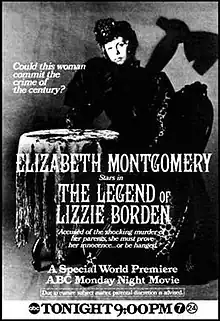| The Legend of Lizzie Borden | |
|---|---|
 | |
| Genre | |
| Written by | William Bast |
| Directed by | Paul Wendkos |
| Starring | Elizabeth Montgomery Katherine Helmond Ed Flanders Fionnula Flanagan Fritz Weaver Amzie Strickland Hayden Rorke |
| Music by | Billy Goldenberg |
| Country of origin | United States |
| Original language | English |
| Production | |
| Producer | George LeMaire |
| Cinematography | Robert Hauser |
| Editor | John A. Martinelli |
| Running time | 96 minutes |
| Production companies | Paramount Television George LeMaire Productions |
| Original release | |
| Network | ABC |
| Release | February 10, 1975 |
The Legend of Lizzie Borden is a 1975 American historical mystery television film directed by Paul Wendkos and starring Elizabeth Montgomery—in an Emmy-nominated performance—as Lizzie Borden, an American woman who was accused of murdering her father and stepmother in 1892. It co-stars Katherine Helmond, Fritz Weaver, Fionnula Flanagan, and Hayden Rorke. It premiered on ABC on February 10, 1975. The film was nominated for a Golden Globe award for Best Motion Picture Made for Television in 1976.
Plot
Although the film is based on fact, it is a stylized retelling of the events of August 4, 1892, the day the father and step-mother of New England spinster Lizzie Borden were found brutally murdered in their Fall River, Massachusetts home. Public interest in Borden and the murders is exacerbated by her aloof demeanor after the murders, and the public speculates about her involvement in them when she fails to express any emotion during her father and stepmother's funerals.
The subsequent incarceration of the prime suspect (Lizzie herself) as well as the coroner's inquest and the trial are faithfully depicted, using actual testimony. During the trial, various persons testify, including Bridget Sullivan, the Borden's maid from Ireland who was the only other person in the home at the time of the murders.
In what may be seen as a deviation from the film's docudrama narrative, as Lizzie hears her verdict, flashbacks are shown of her actually committing the murders in the nude and bathing after each death, explaining why no blood was ever found on her or her clothes; however, the film's plot with regard to Lizzie's role in the murders remains ambiguous because it does not state that Lizzie was actually reminiscing about the crimes nor does it state that she was simply fantasizing about how she herself would have disposed of her victims. When Lizzie returns home after her acquittal, her sister Emma asks her point-blank if she killed their father; Lizzie does not answer. The epilogue states that the killings of Andrew and Abby Borden remain unsolved.
Cast
- Elizabeth Montgomery as Lizzie Borden
- Fionnula Flanagan as Bridget Sullivan
- Ed Flanders as Hosea Knowlton
- Katherine Helmond as Emma Borden
- Don Porter as George Robinson
- Fritz Weaver as Andrew Borden
- Bonnie Bartlett as Sylvia Knowlton
- John Beal as Dr. Bowen
- Helen Craig as Abby Borden
- Alan Hewitt as Mayor Coughlin
- Gail Kobe as Alice Russell
- Hayden Rorke as Julien Ralph
- Amzie Strickland as Adelaide Churchill
- Robert Symonds as Andrew Jennings
Production

Casting
Elizabeth Montgomery and Lizzie Borden were sixth cousins once removed, both descending from 17th-century Massachusetts resident John Luther. Rhonda McClure, the genealogist who documented the Montgomery-Borden connection, said, "I wonder how Elizabeth would have felt if she knew she was playing her own cousin."[2] One of the gowns which was worn by Montgomery in the film is on display at the bed-and-breakfast which now occupies the Borden house.
Irish actress Fionnula Flanagan was cast in the part of the Borden's maid, Bridget Sullivan, who was originally from Ireland.[3]
Reception
Awards
The film won writer William Bast the 1975 Edgar Award for Best TV Feature/Miniseries.[4] It also won two Emmy Awards, for Costume Design (presented to Guy C. Verhille) and Film Editing (John A. Martinelli), and received nominations in three other Emmy categories: Lead Actress (Montgomery), Art Direction (Jack De Shields), and Sound Editing (Harry Gordon).[4]
The film was also nominated for Best Motion Picture Made for Television in the 1976 Golden Globe Awards.
European version
The European theatrical version is more explicit than the theatrical version which was broadcast on ABC, showing Borden nude in the scenes when she kills her father and stepmother. This version also runs an extra 4 minutes, 104 minutes total versus the United States version of 100 minutes.[5]
Release
A Region 1 DVD release of the film was released on October 7, 2014, and is now available for purchase.
References
- ↑ Lentz, Harris M. (1983). Science fiction, Horror and Fantasy Film and Television Credits. McFarland. p. 953. ISBN 978-0-899-50070-6.
- ↑ Pylant, James (2004). "The Bewitching Family Tree of Elizabeth Montgomery". Genealogy Magazine. Archived from the original on 2016-03-04.
"Rhonda R. McClure. Finding Your Famous (& Infamous) Ancestors. (Cincinnati: Betterway Books: 2003), pp. 14-16.
- ↑ "Fionnula Flanagan Biography (1941–)". Film Reference. Retrieved October 7, 2017.
- 1 2 Derry, Charles (2009). Dark Dreams 2.0: A Psychological History of the Modern Horror Film. Jefferson, NC: McFarland. p. 370. ISBN 9780786456956.
- ↑ In appreciation of Elizabeth Montgomery